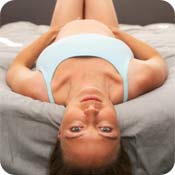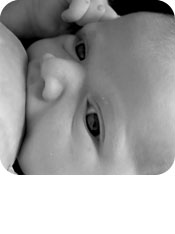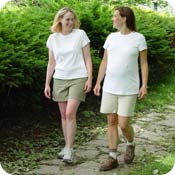 When you get fitted for a new pair of running or walking shoes, go to the experts at a sporting goods store, running store, or even a podiatrist. Ask the expert of your choice to help you evaluate the arch of your foot, of which there are three main types:
When you get fitted for a new pair of running or walking shoes, go to the experts at a sporting goods store, running store, or even a podiatrist. Ask the expert of your choice to help you evaluate the arch of your foot, of which there are three main types:
- Flat-footed folks have low arches and feet that tend to roll inward as you run or walk. Look for a shoe that offers more stability.
- High arches often cause the feet to roll outward when walking. Look for a cushioned shoe with greater flexibility to help absorb shock more effectively. Insoles, inserted inside your shoes, can also help to support heels and arches. They can be bought separately by shoe size and needs.
- "Normal" arches don't fit into either extreme. Most shoes are made to fit these types.
Additionally, there are three different types of pronation. Pronation, the way that your foot moves after striking the ground (often with the heel and ankle rolling inward for balance) is a normal movement.
- Overpronation occurs when the foot rolls excessively inward, which can lead to muscle strains in both your legs and feet. Overpronators also tend to have low arches. Look for "stability" or "motion control" shoes, which are less flexible, have a thicker heel and help decrease excessive pronation.
- Underpronation (supination) describes feet that roll outward when running or walking. Underpronators tend to have high arches or "pigeon-toes." Look for shoes with extra cushioning to help absorb the added impact on your foot strikes.
- Normal pronation is most common, where the foot pronates normally, but not excessively. Look for stability shoes, which are more flexible than motion control shoes but still have good support.
Pregnancy-Related Shoe Tips
- New exercise shoes are almost always needed during pregnancy because of foot size changes.
- During pregnancy, your feet can increase up to a full size in length and also expand in width. They might remain that size after pregnancy.
- Get a professional fitting for new athletic shoes during pregnancy, and allow for extra foot expansion.
- Replace shoes to accommodate for size changes at the end of the first trimester. You can wear heavier socks initially to make up for the increase in shoe size and progress to a light liner sock as your feet expand or swell later in pregnancy.
- Take out the liner that comes with your athletic shoe and replace it with a gel liner for added shock absorption--something really needed with the added weight carried during pregnancy.
- A velcro strap closure can come in very handy when the tummy makes leaning over to tie shoes more difficult!
Additional Shoe Shopping Tips
- Shoes should be replaced every five to six months (or 400-600 miles of running/walking), depending on how often you use them. If the tread (on the outer sole) is worn or if the sides are worn to the point that your shoe leans one way or the other, it's time for a new pair.
- When you try out new shoes, wear the same type of socks that you wear when working out.
- Shop in the evening, when your feet tend to be larger.
- When standing, your shoe should have about a half-inch gap between your longest toe and the toe box of the shoe.
- Walk or jog around the store (some will even let you try it outside) to see how the shoes feel. Try movements that you plan to use this shoe for (jumping, marching, aerobics, etc.) Your feet shouldn't slide back and forth or side-to-side as you move around.
*This article has been reviewed by Jen Mueller, personal trainer and marathon runner.
|
 When you get fitted for a new pair of running or walking shoes, go to the experts at a sporting goods store, running store, or even a podiatrist. Ask the expert of your choice to help you evaluate the arch of your foot, of which there are three main types:
When you get fitted for a new pair of running or walking shoes, go to the experts at a sporting goods store, running store, or even a podiatrist. Ask the expert of your choice to help you evaluate the arch of your foot, of which there are three main types:



.jpg)


Member Comments